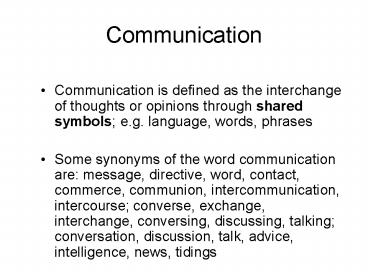Communication - PowerPoint PPT Presentation
1 / 20
Title:
Communication
Description:
Communication Communication is defined as the interchange of thoughts or opinions through shared symbols; e.g. language, words, phrases Some synonyms of the word ... – PowerPoint PPT presentation
Number of Views:225
Avg rating:3.0/5.0
Title: Communication
1
Communication
- Communication is defined as the interchange of
thoughts or opinions through shared symbols e.g.
language, words, phrases - Some synonyms of the word communication are
message, directive, word, contact, commerce,
communion, intercommunication, intercourse
converse, exchange, interchange, conversing,
discussing, talking conversation, discussion,
talk, advice, intelligence, news, tidings
2
Why we communicate
- We communicate to
- Share our ideas and opinions
- Provide feedback to others
- Get information from others
- Gain power and influence
- Develop social relationships
- Maintain self-expression and our culture
- and other ideas you may have thought of
3
Four facets of communication
- In any communication
- The Sender is the person trying to communicate a
message - The Receiver is the person at whom the message is
directed - A message is sent to convey information
- Information is meant to change behavior
4
How we communicate
- We communicate and build interpersonal
relationships through - Speech
- Writing
- Listening
- Non-verbal language
- Music, art, and crafts
5
Shared symbols
- Sometimes when we communicate we assume we are
using shared symbols when we might not be - Think about the term asap, as soon as
possible. What does it really mean? - Think about how the meaning might change in the
situations on the next slide
6
(No Transcript)
7
(No Transcript)
8
Barriers to communication
- What are barriers to communication that exist in
any work setting? - Take a few moments to write
down some of your thoughts
9
Barriers to communication
- Some common barriers to interpersonal
communication include - Unclear process The receiver and sender may not
share the same language, slang, jargon,
vocabulary, symbols - Chain of command There may be too many layers
that a message passes through between sender and
receiver - Large size of an organization, geographic
distance Large numbers of receivers require good
message sending methods - Personal limitations Physical and mental
disabilities, and differences in intelligence and
education may interfere with mutual understanding
10
Barriers to communication
- Additional common barriers to interpersonal
communication include - Human nature Peoples egos, prejudices, and
traditions can get in the way - Conflicting feelings, goals, opinions If people
feel on opposite sides of an issue they may not
share - Power The idea that knowledge is power can lead
to information hoarding - and other ideas you may have thought of
11
Obstacles to getting good information
- Lack of trust
- Assuming you already know it all
- Jumping to conclusions
- Not valuing diverse opinions
- Weak reading skills
- Weak listening skills
- Weak questioning skills
- and other ideas you may have thought of
12
Body language
- Nonverbal communication, known as body language
sends strong positive and negative signals. This
is how much it influences any message - Words 8
- Tone of voice 34
- Non-verbal cues 58
- Message 100
13
Body language includes
- Face
- Figure
- Focus
- Territory
- Tone
- Time
- Each of these is described in the following
slides
14
Body language - face
- Face includes
- Your expressions
- Your smile or lack thereof
- Tilt of the head e.g., if your head is tilted to
one side, it usually indicates you are interested
in what someone is saying - What message are you sending if someone is
presenting a new idea and you are frowning?
15
Body language - figure
- Figure includes
- Your posture
- Your demeanor and gestures
- Your clothes and accessories such as jewelry
- What message are you sending if you are dressed
casually at an important meeting?
16
Body language - focus
- Focus is your eye contact with others
- The perception of eye contact differs by culture.
For most Americans - Staring makes other people uncomfortable
- Lack of eye contact can make you appear weak or
not trustworthy - Glasses may interfere or enhance eye contact
- What message are you sending if you are looking
at other things and people in a room when someone
is speaking to you?
17
Body language - territory
- Territory focuses on how you use space. It is
also called proxemics. - The perception of territory differs by culture.
Most Americans are comfortable with an individual
space that is about an arms length in diameter - What message are you sending if you keep moving
closer to a person who is backing away from you?
18
Body language - tone
- Tone is a factor of your voice
- Pitch is the highness or lowness of voice
- Volume is how loud your voice is
- Emphasis is your inflection
- What message are you sending if during a
disagreement you start speaking very loudly?
19
Body language - time
- Time focuses on how you use time. It is also
called chronemics. - Pace is how quickly you speak
- Response is how quickly you move
- Punctuality is your timeliness
- What message are you sending if you are
consistently late for meetings?
20
Ideas to walk away with
- People are always communicating
- The meaning intended by the sender is never
exactly the message gotten by the receiver - We can help to overcome barriers to communication
by being aware of them - Verbal and non-verbal communication is important
in sending our messages































